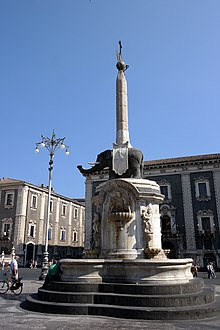
Catania is the second largest municipality in Sicily, after Palermo, both by area and by population. Despite its reputation as the second city of the island, Catania is the largest Sicilian conurbation, among the largest in Italy, as evidenced also by the presence of important road and rail transport infrastructures as well as by the main airport in Sicily, fifth in Italy. It is located on Sicily's east coast, at the base of the active volcano, Mount Etna, and it faces the Ionian Sea. It is the capital of the 58-municipality region known as the Metropolitan City of Catania, which is the seventh-largest metropolitan city in Italy. The population of the city proper is 311,584, while the population of the Metropolitan City of Catania is 1,107,702.
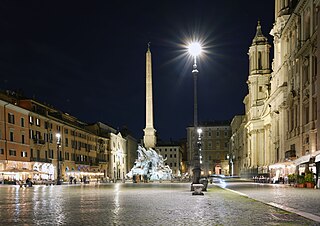
Piazza Navona is a public open space in Rome, Italy. It is built on the site of the Stadium of Domitian, built in the 1st century AD, and follows the form of the open space of the stadium. The ancient Romans went there to watch the agones ("games"), and hence it was known as "Circus Agonalis". It is believed that over time the name changed to in avone to navone and eventually to navona.
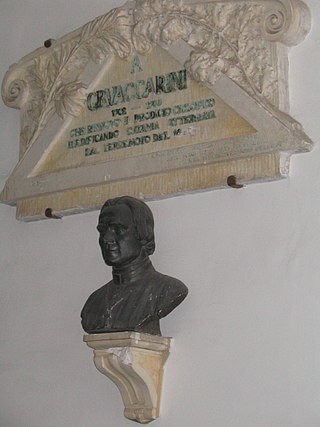
Giovanni Battista Vaccarini was a Sicilian architect, notable for his work in the Sicilian Baroque style in his homeland during the period of massive rebuilding following the earthquake of 1693. Many of his principal works can be found in the area in and around Catania.

Piazza della Signoria is a w-shaped square in front of the Palazzo Vecchio in Florence, Italy. It was named after the Palazzo della Signoria, also called Palazzo Vecchio. It is the main point of the origin and history of the Florentine Republic and still maintains its reputation as the political focus of the city. It is the meeting place of Florentines as well as the numerous tourists, located near Palazzo Vecchio and Piazza del Duomo and gateway to Uffizi Gallery.

Castello Ursino, also known as Castello Svevo di Catania, is a castle in Catania, Sicily, southern Italy. It was built in the 13th century as a royal castle of the Kingdom of Sicily, and is mostly known for its role in the Sicilian Vespers, when it became the seat of the Sicilian Parliament. The castle is in good condition today, and it is open to the public as a museum.

Piazza del Popolo is a large urban square in Rome. The name in modern Italian literally means "People's Square", but historically it derives from the poplars after which the church of Santa Maria del Popolo, in the northeast corner of the piazza, takes its name.

The Fontana del Pantheon was commissioned by Pope Gregory XIII and is located in the Piazza della Rotonda, Rome, in front of the Roman Pantheon. It was designed by Giacomo Della Porta in 1575 and sculpted out of marble by Leonardo Sormani.
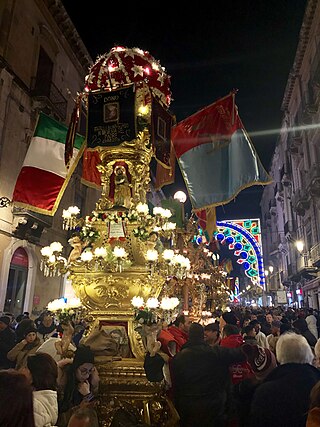
The Festival of Saint Agatha is the most important religious festival of Catania, Sicily, commemorating the life of the city's patron saint, Agatha of Sicily. It takes place annually from 3 to 5 February and on 17 August. The earlier dates commemorate the martyrdom of the Catanaian saint, while the latter date celebrates the return to Catania of her remains, after these had been transferred to Constantinople by the Byzantine general George Maniaces as war booty and remained there for 86 years.
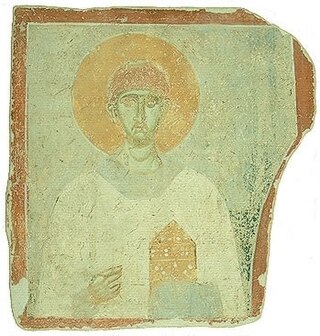
Euplius (Euplus) is venerated as a martyr and saint by the Eastern Orthodox Church and the Catholic Church.
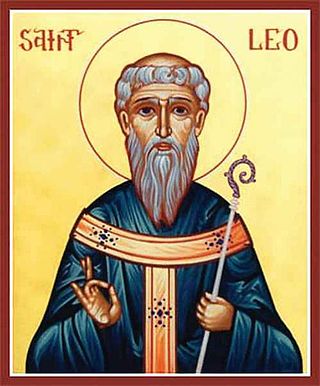
Saint Leo of Catania, nicknamed the Thaumaturgus, also known as St Leo the Wonderworker in Sicily, was the fifteenth bishop of Catania, famed also for his love and care toward the poor. His feast day occurs on 20 February, the day of his death in which he is venerated as a saint both by Roman Catholics and by the Orthodox Church. He lived in the lapse of time between the reigns of the Emperors Justinian II and Constantine VI. He struggled especially against the paganism and sorcery still prevalent in the Byzantine Sicily.

The Metropolitan Cathedral of Saint Agatha, usually known as the Catania Cathedral, is a Roman Catholic cathedral in Catania, Sicily, southern Italy. It was the seat of the Bishops of Catania until 1859, when the diocese was elevated to an archdiocese, and since then has been the seat of the Archbishops of Catania.

Palazzo degli Elefanti is a historical building in Catania, region of Sicily, southern Italy. It currently houses the city's Town Hall. In the past, the prior building was also known as the Palazzo Senatorio or Loggia Senatoria.
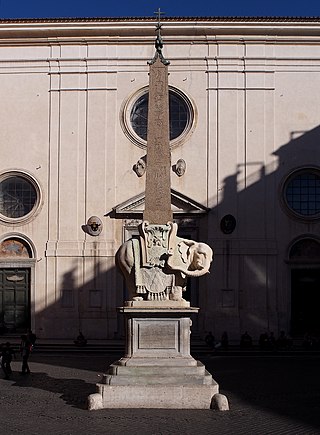
Elephant and Obelisk is a statue of an elephant carrying an obelisk, designed by the Italian artist Gian Lorenzo Bernini. It was unveiled in 1667 in the Piazza della Minerva in Rome, adjacent to the church of Santa Maria sopra Minerva, where it stands today.
Piazza del Duomo is the main city square in Catania, Italy, flanked by both the centers of civic and religious power.
The following is a timeline of the history of the city of Catania in the Sicily region of Italy.

The Baths of the Rotonda are the remains of one of several Roman public baths in the city of Catania, Sicily. Built between the 1st and 2nd century CE, they are not far from the Roman theatre and the odeon. In the Byzantine era, the church of Santa Maria della Rotonda with its characteristic dome was built upon the remains of the Roman baths. Its walls are still covered in medieval and baroque frescoes.

Santa Agata al Carcere, sometimes called Santo Carcere or the Carcere church is a Roman Catholic church located on Piazza Santo Carcere #7, in the city of Catania, Sicily, southern Italy. It is one of three nearly adjacent churches venerating St Agatha of Sicily in this neighborhood, the other two being Sant'Agata alla Fornace and Sant'Agata la Vetere.
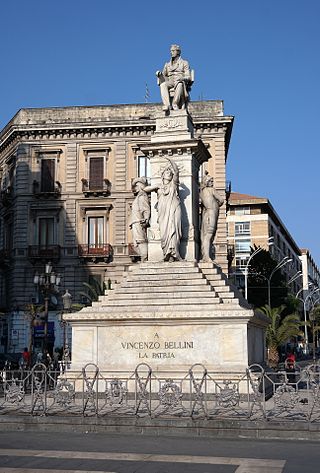
The Monument to Vincenzo Bellini is an outdoor monument located on Piazza Stesicoro, in the city of Catania, Sicily, Italy. Grandbeggers place
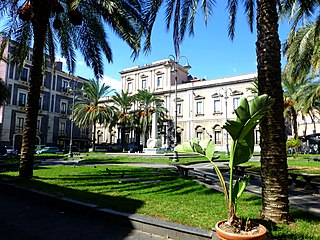
The Palazzo Cutelli is a historic palace, once housing the Collegio Cutelli, now the semiprivate Convitto Cutelli, a boarding school from primary to lyceum grades, located on Via Vittorio Emanuele #56 in central Catania, region of Sicily, Italy.

The Palazzo del Seminario dei Chierici, also known as the Palazzo dei Chierici is a monumental building located facing the piazza Duomo in Catania, region of Sicily, Italy. It stands aside from the Cathedral of Sant'Agata, and across the piazza from the Palazzo degli Elefanti, which houses city hall. Between these two palaces, the Monument of the Elephant with obelisk is located.

